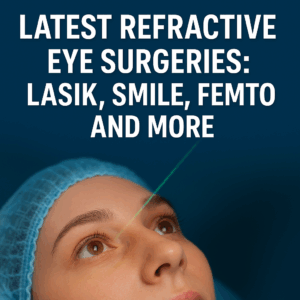
Anushka Super Speciality Eye Hospital
Call: 90044 44422 / 99213 44422 | Timings : 8.30 a.m to 5.30 p.m (Mon-Sat) | Add: Shri Swami Samarth Soc, Kaneri Dhamankar Naka, Bhiwandi




Accredited for Quality Care
Debunking Myths and Uncovering Facts About Cataract and Cataract Surgery
anushka
10 July 2025
Cataract is one of the leading causes of reversible blindness worldwide. Despite advancements in eye care and surgical techniques, misinformation and fear still surround this common condition. This article aims to bust common myths and clarify the facts about cataracts and cataract surgery.
What Is a Cataract?
A cataract is a clouding of the natural lens of the eye, located behind the iris and pupil. This lens focuses light onto the retina for clear vision. When the lens becomes cloudy, it results in blurred or dull vision.
Cataracts usually develop slowly and are most common in older adults, but they can also occur due to trauma, diabetes, long-term steroid use, or even congenitally.
Common Myths and Facts About Cataract and Cataract Surgery
Myth 1: Cataract is a film over the eye.
Fact:
This is one of the oldest and most widespread misconceptions. Cataracts do not form as a film over the eye or lens. Instead, the lens itself becomes cloudy due to protein changes within it.
Myth 2: Only elderly people get cataracts.
Fact:
Although age-related cataracts are most common, cataracts can occur at any age. Congenital cataracts can be present at birth, while trauma, UV exposure, certain medications (like corticosteroids), and diabetes can lead to early cataract formation.
Myth 3: Cataracts can be treated with eye drops or medications.
Fact:
As of now, no eye drops or medications can reverse or cure cataracts. The only definitive treatment for cataracts is surgical removal of the cloudy lens and replacement with a clear artificial intraocular lens (IOL).
Myth 4: Cataract surgery is dangerous and should be delayed as long as possible.
Fact:
Cataract surgery is one of the safest and most effective surgeries worldwide, with a success rate exceeding 98%. Modern phacoemulsification and robotic-assisted techniques make the procedure minimally invasive, often completed in under 20 minutes. Delaying surgery can cause more complications, including hypermature cataracts, which are harder to remove and riskier.
Myth 5: Cataracts must be “ripe” before surgery.
Fact:
This outdated notion no longer applies. Today’s advanced surgical methods allow cataracts to be removed at any stage, depending on how much they affect a person’s vision and daily life. There’s no need to wait until vision is severely impaired.
Myth 6: Cataract surgery is painful and requires hospitalization.
Fact:
Modern cataract surgery is typically painless, performed under local or topical anesthesia, and does not require hospital admission. Most patients go home the same day and return to normal activities in a few days.
Myth 7: Cataract can return after surgery.
Fact:
Once the cataract is removed, it cannot grow back. However, some patients may develop a condition called posterior capsule opacification (PCO), sometimes called a “secondary cataract.” This is easily treated with a painless YAG laser procedure in a few minutes.
Myth 8: After cataract surgery, you will need glasses permanently.
Fact:
With premium intraocular lenses (IOLs) such as multifocal, toric, or trifocal lenses, many patients experience greatly reduced dependence on glasses, or may not need them at all for daily activities. However, some patients might still need glasses for reading or computer work, depending on the lens chosen.
Myth 9: Both eyes are operated on the same day.
Fact:
Generally, cataract surgery is performed on one eye at a time, with the second eye done a few days or weeks later. This ensures proper healing and optimal vision outcome.
Understanding the Cataract Surgery Procedure
Cataract surgery involves removing the cloudy natural lens and replacing it with a clear artificial lens called an intraocular lens (IOL). Here’s a brief overview of the modern technique:
- Phacoemulsification: A tiny probe uses ultrasound energy to break up the lens, which is then suctioned out.
- Laser-Assisted Surgery: Robotic or femtosecond laser aids in precise incisions and lens fragmentation.
- Lens Implantation: A foldable IOL is inserted through a tiny incision and unfolds in the eye.
- No-Stitch, Painless Surgery: The self-sealing incision usually doesn’t require stitches.
The whole procedure takes about 15–20 minutes, and patients can often see improvements within a few hours.
Benefits of Early Cataract Surgery
- Improved vision and quality of life
- Reduced risk of falls and accidents in the elderly
- Better control of co-existing eye diseases (like glaucoma or diabetic retinopathy)
- Greater surgical ease and reduced complications
How to Prevent or Delay Cataracts
While not all cataracts can be prevented, you can reduce your risk with the following tips:
- Wear UV-protective sunglasses
- Control diabetes and hypertension
- Avoid smoking and excessive alcohol
- Eat antioxidant-rich foods like fruits and leafy greens
- Use protective eyewear during work or sports
- Have regular eye checkups, especially after age 40
Frequently Asked Questions (FAQs)
1. At what age do cataracts usually begin?
Most cataracts develop after the age of 50, but early-onset cataracts can occur due to genetics, trauma, or medical conditions.
2. Is cataract surgery covered under insurance?
Yes, most health insurance plans in India and globally cover cataract surgery, including the cost of basic intraocular lenses.
3. How long is the recovery period?
Most patients resume normal activities within 3–5 days. Complete healing may take a few weeks, but vision often improves quickly.
4. Can both eyes be done together?
It is possible in some high-tech settings, but usually, surgeries are done one eye at a time for safety and better recovery.
5. Will cataract surgery correct my glasses number?
Yes, depending on the type of IOL you choose, cataract surgery can significantly reduce or even eliminate your need for glasses.
Conclusion
Cataract and cataract surgery are surrounded by unnecessary myths that can delay timely treatment and lead to avoidable vision loss. With today’s technology and skilled surgeons, cataract surgery is one of the most successful medical procedures. If you’re experiencing blurred vision, glare, or difficulty reading, consult an eye specialist.
Don’t wait for the “right time.” The best time is when your vision starts to interfere with your life.
Recent Posts


